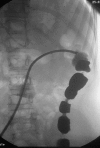General paediatric surgical provision of percutaneous endoscopic gastrostomy in a district general hospital--a 12-year experience
- PMID: 19344554
- PMCID: PMC2758436
- DOI: 10.1308/003588409X391749
General paediatric surgical provision of percutaneous endoscopic gastrostomy in a district general hospital--a 12-year experience
Abstract
Introduction: A small, but significant, number of children require long-term nutritional support. The aim of this study was to demonstrate the safety and efficacy of providing a percutaneous endoscopic gastrostomy (PEG) service for children in a district general hospital and to raise awareness of the suitability of the procedure to be performed on paediatric surgery lists in similar hospitals across the UK.
Patients and methods: A multidisciplinary paediatric nutrition team was established and all children accepted for PEG insertion between 1995 and 2007 were entered onto a database prospectively and are included in this study. PEG tubes were inserted by the standard pull-through technique under general anaesthetic.
Results: A total of 172 procedures were performed in 76 children. The median age at first tube insertion was 3 years (range, 0.5-18 years). Length of follow-up ranged from 1 month to 12.6 years. Fifty-eight children (76%) had a neurological abnormality, the commonest being cerebral palsy. All but one procedure were performed successfully, of which 63 (37%) were new insertions, 99 change of tube, 4 changed from surgical gastrostomy and 6 from PEG to button gastrostomy. The median hospital stay was 2 days (range, 2-7 days) for new insertions and 1 day for tube changes. There were 10 (6%) early complications within 30 days, the commonest being peritubal infection (6). The 39 late complications included 16 peritubal infection/granulomata, 9 'buried bumpers', 4 worsening of gastro-oesophageal reflux disease, 2 gastrocolic fistulae, 3 gastrocutaneous fistulae and 4 tubal migration. There was no mortality.
Conclusions: We have demonstrated that paediatric PEG procedures and continuing management by a supporting team can be successfully and efficiently provided in the district general hospital. It should be possible for the majority of similar hospitals to provide local access and increase the availability of PEG feeding for children.
Figures
Similar articles
-
The protocol for a randomised-controlled trial of the evaluation of the tolerance and safety of early enteral nutrition in children after percutaneous endoscopic gastrostomy placement. (protocol version 09.01.2015).BMC Pediatr. 2016 Oct 7;16(1):163. doi: 10.1186/s12887-016-0705-8. BMC Pediatr. 2016. PMID: 27717336 Free PMC article. Clinical Trial.
-
Prospective experience of percutaneous endoscopic gastrostomy tubes placed by otorhinolaryngologist-head and neck surgeons: safe and efficacious.Eur Arch Otorhinolaryngol. 2017 Nov;274(11):3971-3976. doi: 10.1007/s00405-017-4732-3. Epub 2017 Sep 1. Eur Arch Otorhinolaryngol. 2017. PMID: 28865046
-
Percutaneous endoscopic gastrostomy in the neurosurgical intensive care unit: complications and outcome.JPEN J Parenter Enteral Nutr. 2007 Nov-Dec;31(6):517-20. doi: 10.1177/0148607107031006517. JPEN J Parenter Enteral Nutr. 2007. PMID: 17947610
-
Percutaneous endoscopic gastrostomy in children.Can J Gastroenterol. 2008 Dec;22(12):993-8. doi: 10.1155/2008/583470. Can J Gastroenterol. 2008. PMID: 19096739 Free PMC article. Review.
-
Enteral feeding and percutaneous endoscopic gastrostomy.Nurs Stand. 2004 Jan 28-Feb 3;18(20):41-3. doi: 10.7748/ns2004.01.18.20.41.c3536. Nurs Stand. 2004. PMID: 14976704 Review.
Cited by
-
Gastrostomy insertion in the 21st century: PEG or laparoscopic? Report from a large single-centre series.Pediatr Surg Int. 2012 May;28(5):443-8. doi: 10.1007/s00383-012-3079-5. Epub 2012 Apr 3. Pediatr Surg Int. 2012. PMID: 22476714
-
Gastrostomy tube feeding in children: a single-center experience.BMC Gastroenterol. 2025 Jan 10;25(1):12. doi: 10.1186/s12876-024-03582-4. BMC Gastroenterol. 2025. PMID: 39794725 Free PMC article.
-
The relationship between percutaneous endoscopic gastrostomy and gastro-oesophageal reflux disease in children: a systematic review.Surg Endosc. 2012 Sep;26(9):2504-12. doi: 10.1007/s00464-012-2221-8. Epub 2012 Mar 22. Surg Endosc. 2012. PMID: 22437953
References
-
- Gauderer MW, Ponsky JL, Izant RJ. Gastrostomy without laparotomy: a percutaneous endoscopic technique. J Pediatr Surg. 1980;15:872–5. - PubMed
-
- Annual BANS Report: Trends in Artificial Nutrition Support in the UK 2000–2003. BAPEN 2005, ISBN 1 899467 95 5.
-
- Fox VL, Abel SD, Malas S, Duggan C, Leichtner AM. Complications following percutaneous endoscopic gastrostomy and subsequent catheter replacement in children and young adults. Gastrointest Endosc. 1997;45:64–71. - PubMed
-
- Ljungdahl M, Sundbom M. Complication rate lower after percutaneous endoscopic gastrostomy than after surgical gastrostomy: a prospective, randomized trial. Surg Endosc. 2006;20:1248–51. - PubMed
-
- Hamidon BB, Abdullah SA, Zawawi MF, Sukumar N, Aminuddin A, Raymond AA. A prospective comparison of percutaneous endoscopic gastrostomy and nasogastric tube feeding in patients with acute dysphagic stroke. Med J Malaysia. 2006;61:59–66. - PubMed
MeSH terms
LinkOut - more resources
Full Text Sources


